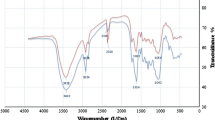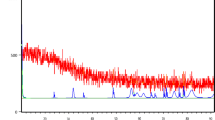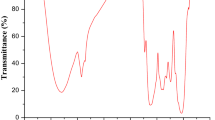Abstract
The adsorption of Cu(II) ions by sodium-hydroxide-treated Imperata cylindrica (SoHIC) leaf powder was investigated under batch mode. The influence of solution pH, adsorbent dosage, shaking rate, copper concentration, contact time, and temperature was studied. Copper adsorption was considered fast as the time to reach equilibrium was 40–90 min. Several kinetic models were applied and it was found that pseudo-second-order fitted well the adsorption data. In order to understand the mechanism of adsorption, spectroscopic analyses involving scanning electron microscope (SEM) coupled with energy-dispersive spectroscopy (EDS) and Fourier transform infrared (FTIR) spectrophotometer were carried out. Ion exchange was proven the main mechanism involved as indicated by EDS spectra and as there was a release of light metal ions (K+, Na+, Mg2+, and Ca2+) during copper adsorption. Complexation also occurred as demonstrated by FTIR spectra involving hydroxyl, carboxylate, phosphate, ether, and amino functional groups. The equilibrium data were correlated with Langmuir, Freundlich, and Dubinin–Radushkevich isotherm models. Based on Langmuir model, the maximum adsorption capacity was recorded at the highest temperature of 310 K, which was 11.64 mg g−1.









Similar content being viewed by others

References
Abu Al-Rub, F. A., El-Naas, M. H., Ashour, I., & Al-Marzouqi, M. (2006). Biosorption of copper on Chlorella vulgaris from single, binary and ternary metal aqueous solutions. Process Biochemistry, 41, 457–464. doi:10.1016/j.procbio.2005.07.018.
Akar, T., & Tunali, S. (2005). Biosorption performance of Botrytis cinerea fungal by-products for removal of Cd(II) and Cu(II) ions from aqueous solutions. Minerals Engineering, 18, 1099–1109. doi:10.1016/j.mineng.2005.03.002.
Aman, T., Kazi, A. A., Sabri, M. U., & Bano, Q. (2008). Potato peels as solid waste for the removal of heavy metal copper (II) from waste water/industrial effluent. Colloids and Surfaces B, Biointerfaces, 63, 116–121. doi:10.1016/j.colsurfb.2007.11.013.
Amuda, O. S., Giwa, A. A., & Bello, I. A. (2007). Removal of heavy metal from industrial wastewater using modified activated coconut shell carbon. Biochemical Engineering Journal, 36, 174–181. doi:10.1016/j.bej.2007.02.013.
AOAC (1997). Official methods of analysis of Association of Analytical Chemists International (16th ed.). Gaithersburg: AOAC.
Argun, M. E., Dursun, S., Ozdemir, C., & Karatas, M. (2007). Heavy metal adsorption by modified oak sawdust: Thermodynamics and kinetics. Journal of Hazardous Materials, 141, 77–85. doi:10.1016/j.jhazmat.2006.06.095.
Badmus, M. O. A., Audu, T. O. K., & Anyata, B. (2006). Removal of copper from industrial wastewaters by activated carbon prepared from periwinkle shells. Korean Journal of Chemical Engineering, 24, 246–252. doi:10.1007/s11814-007-5049-5.
Balistrieri, L. S., & Murray, J. W. (1981). The surface chemistry of goethite (α-FeOOH) in major ion seawater. American Journal of Science, 281, 788–806.
Chen, H., Zhao, Y., & Wang, A. (2007). Removal of Cu(II) from aqueous solution by adsorption onto acid-activated palygorskite. Journal of Hazardous Materials, 149, 346–354. doi:10.1016/j.jhazmat.2007.03.085.
Demirbas, A. (2008). Heavy metal adsorption onto agro-based waste materials: A review. Journal of Hazardous Materials, 157, 220–229. doi:10.1016/j.jhazmat.2008.01.024.
Dubinin, M. M., Zaverina, E. D., & Radushkevich, L. V. (1947). Sorption and structure of active carbons. I. Adsorption of organic vapors. Journal of Physical Chemistry, 21, 1351–1362.
Ferro-García, M. A., Rivera-Utrilla, J., Rodríguez-Gordillo, J., & Bautista-Toledo, I. (1998). Adsorption of zinc, cadmium and copper on activated carbons obtained from agricultural by-products. Carbon, 26, 363–373. doi:10.1016/0008-6223(88)90228-X.
Freundlich, H. M. F. (1906). ϋber die adsorption in läsungen. Zeitschrift für Physikalische Chemie, 57, 385–470.
Gasser, M. S., Morad, G. A., & Aly, H. F. (2006). Equilibrium and kinetics study of Gd(III) and U(VI) adsorption from aqueous solutions by modified Sorrel’s cement. Adsorption, 12, 65–76. doi:10.1007/s10450-006-0139-y.
Gündoğan, R., Acemioğlu, B., & Alma, M. H. (2004). Copper (II) adsorption from aqueous solution by herbaceous peat. Journal of Colloid and Interface Science, 269, 303–309. doi:10.1016/S0021-9797(03)00762-8.
Güzel, F., Yakut, H., & Topal, G. (2008). Determination of kinetic and equilibrium parameters of the batch adsorption of Mn(II), Co(II), Ni(II) and Cu(II) from aqueous solution by black carrot (Daucus carota L.) residues. Journal of Hazardous Materials, 153, 1275–1287. doi:10.1016/j.jhazmat.2007.09.087.
Ho, Y. S., & McKay, G. (1998). A comparison of chemisorption kinetic models applied to pollutant removal on various sorbents. Process Safety and Environmental Protection, 76, 332–340. doi:10.1205/095758298529696.
Ho, Y. S., & McKay, G. (2000). The kinetics of sorption of divalent metal ions onto sphagnum moss peat. Water Research, 34, 735–742. doi:10.1016/S0043-1354(99)00232-8.
Ho, Y. S., & McKay, G. (2004). Sorption of copper(II) from aqueous solution by peat. Water, Air, and Soil Pollution, 158, 77–97. doi:10.1023/B:WATE.0000044830.63767.a3.
Holm, L. G., Plucknett, D. L., Pancho, J. V., & Herberger, H. P. (1977). The world’s worst weeds: Distribution, and biology. Honolulu: University Press of Hawaii.
Isaac, R. A., & Kerber, J. D. (1971). Atomic absorption and flame photometry: Techniques and uses in soil, plant and water analysis. In L. M. Walsh (Ed.), Instrumental methods for analysis of soils and plant tissue (pp. 17–37). Madison: Soil Science Society of America Inc.
Kannan, N., & Rengasamy, G. (2005). Comparison of cadmium ion adsorption on various activated carbons. Water, Air, and Soil Pollution, 163, 185–201. doi:10.1007/s11270-005-0277-y.
Kim, T. Y., Park, S. K., Cho, S. Y., Kim, H. B., Kang, Y., Kim, S. D., et al. (2005). Adsorption of heavy metals by brewery biomass. Korean Journal of Chemical Engineering, 22, 91–98. doi:10.1007/BF02701468.
Kiran, I., Akar, T., & Tunali, S. (2005). Biosorption of Pb(II) and Cu(II) from aqueous solutions by pretreated biomass of Neurospora crassa. Process Biochemistry, 40, 3550–3558. doi:10.1016/j.procbio.2005.03.051.
Küçükgül, E. Y., & Kutlu, S. (2006). Zinc and copper adsorption from an aqueous solution onto activated carbon. Fresenius Environmental Bulletin, 15, 512–517.
Lale, M., Temoçin, Z., & Bag, H. (2005). Sorption behaviour of copper(II), zinc(II) and nickel(II) on formaldehyde cross-linked Saccharomyces cerevisiae immobilized on pumice stone. Fresenius Environmental Bulletin, 10, 736–740.
Langmuir, I. (1916). The constitution and fundamental properties of solids and liquids. Journal of the American Chemical Society, 38, 2221–2295. doi:10.1021/ja02268a002.
Megat Hanafiah, M. A. K., Ibrahim, S. C., & Yahya, M. Z. A. (2006). Equilibrium adsorption study of lead ions onto sodium hydroxide modified Imperata cylindrica leaf powder. Journal of Applied Sciences Research, 2, 1169–1174.
Noh, J. S., & Schwarz, J. A. (1990). Estimation of the point of zero charge of simple oxides by mass titration. Journal of Colloid and Interface Science, 130, 157–164. doi:10.1016/0021-9797(89)90086-6.
O’Connell, D. W., Birkinshaw, C., & O’Dwyer, T. F. (2008). Heavy metal adsorbents prepared from the modification of cellulose: A review. Bioresource Technology, 99, 6709–6724. doi:10.1016/j.biortech.2008.01.036.
Onyango, M. S., Kojima, Y., Kumar, A., & Kuchar, D. (2006). Uptake of fluoride by Al3+ pretreated low-silica synthetic zeolites: Adsorption equilibrium and rate studies. Separation Science and Technology, 41, 683–704. doi:10.1080/01496390500527019.
Salehi, P., Asghari, B., & Mohammadi, F. (2008). Removal of heavy metals from aqueous solutions by Cercis siliquastrum L. Journal of the Iranian Chemical Society, 5, 80–86.
Sengorur, B., Ogleni, O., & Ogleni, N. (2006). Removal of copper and zinc from automotive wastewater by purolite C-104 ion exchange resin. Fresenius Environmental Bulletin, 15, 182–185.
Strelko, V., Malik, D. J., & Streat, M. (2002). Characterisation of the surface of oxidized carbon adsorbents. Carbon, 40, 95–104. doi:10.1016/S0008-6223(01)00082-3.
Upendra, K., & Bandyopadhyay, M. (2006). Sorption of cadmium from aqueous solution using pretreated rice husk. Bioresource Technology, 97, 104–109. doi:10.1016/j.biortech.2005.02.027.
Veglio’, F., & Beolchini, F. (1997). Removal of metals by biosorption: A review. Hydrometallurgy, 44, 30–316.
Villaescusa, I., Fiol, N., & Martínez, M. (2004). Removal of copper and nickel ions from aqueous solutions by grape stalks wastes. Water Research, 38, 992–1002.
Wan Ngah, W. S., & Hanafiah, M. A. K. M. (2008a). Removal of heavy metal ions from wastewater by chemically modified plant wastes as adsorbents: A review. Bioresource Technology, 99, 3935–3948.
Wan Ngah, W. S., & Hanafiah, M. A. K. M. (2008b). Adsorption of copper on rubber (Hevea brasiliensis) leaf powder: kinetic, equilibrium and thermodynamic studies. Biochemical Engineering Journal, 39, 521–530.
Wan Ngah, W. S., & Hanafiah, M. A. K. M. (2008c). Surface modification of rubber (Hevea brasiliensis) leaves for the adsorption of copper ions: kinetic, thermodynamic and binding mechanisms. Journal of Chemical Technology and Biotechnology. doi:10.1002/jctb.2024.
Acknowledgement
The authors gratefully acknowledge the Malaysian Ministry of Higher Education for providing financial support under Fundamental Research Grant Scheme of 011000070004.
Author information
Authors and Affiliations
Corresponding author
Rights and permissions
About this article
Cite this article
Hanafiah, M.A.K.M., Zakaria, H. & Wan Ngah, W.S. Preparation, Characterization, and Adsorption Behavior of Cu(II) Ions onto Alkali-Treated Weed (Imperata cylindrica) Leaf Powder. Water Air Soil Pollut 201, 43–53 (2009). https://doi.org/10.1007/s11270-008-9926-2
Received:
Accepted:
Published:
Issue Date:
DOI: https://doi.org/10.1007/s11270-008-9926-2



